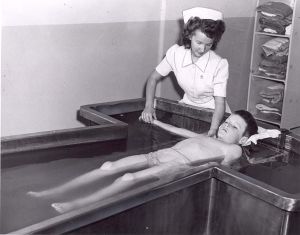Poliomyelitis
Original Editor -Chrysolite Jyothi Kommu
Top Contributors - Chrysolite Jyothi Kommu, Nikhil Benhur Abburi, Momina Khalid and Simisola AjeyalemiPolio[edit | edit source]
Poliomyelitis or Polio is a virus infection of cranial nerve nuclei in the brain stem leading to temporary or permanent paralysis of muscles that they activate[1].The virus affects children under 5 years of age[2]
Mode of transmission-The spread is mainly by fecal contamination route and by droplet infection.Poliovirus is an Enterovirus that colonises the GIT.
Epidemology of poliovirus[edit | edit source]
Polio is caused with a virus of three types[1][3]
- Type-1-Brunhilde,
- Type-2-Lanchi,
- Type-3-Leon.
Since the launch of Global Poliomyelitis Eradication Initiative in 1988,there is a considerable progress in the spread of the virus.[4]
Prevalence[edit | edit source]
Due to vaccination,The prevalence is so low.33 cases were identified in 2018[5][6]
Pathology[edit | edit source]
- Alimentary Stage-After gaining access to the body through the nasopharynx on the GIT,the virus muliplies in the epithelial cells of the intestinal mucosa.
- Viremic Stage-The virus spreads through the blood stream and after a sort of conflict between the virus and the antibodies,in case the virus turns victorious then it leads to the third stage.
- Neural Stage-The virus finds its way to the anterior horn cells of the spinal cord and nerve cells in the brain stem..-
Clinical features[edit | edit source]
The course of the disease is divided into four stages:
Prodromal Stage or Pre-Paralytic Stage- few hours to a few days and 1 to 3 days is the usual duration.
Signs and Symptoms
- Headache.
- Sore throat.
- Malaise.
- Slight Cough.
- Diarrhea or constipation.
- Backache.
- Joint pains.
- Pyrexia of variable duration and severity.
- Mild neck stiffness.
- Irritability.
Treatment
The only practical measures which can be taken-is to stop the playing of games and other such manual work if possible.The nasopharyngeal secretions and feces or highly effective at this stage of illness.An additional booster dose may be given
Acute Stage-3 to 6 weeks from the onset of Poliomyelitis.
Signs and Symptoms
- Muscle tenderness is the most important sign seen in this stage.
- to test this press the calf muscles when child is quiet.If he cries,he has tenderness.
Treatment
- Rest-The child should not be over handled.
- Isolation
- Booster dose
- Nutrition-Diet rich in" Protein".
- Sister Kenny's Bath:This is a form of moist heat.This helps to resolve inflammation to some extent.
Massage should not be given as it may cause more damage due to which the patient may not be able to walk later on.[7][1]
- MMT.
Convalescent Stage- Duration 3 months.
Signs and Symptoms
- Spinal Type-The" lower limb muscles are more often involved".Flexion contractures of hip,knee and equinus deformity of the ankle are common.
- Bulbar Type-The most important sign of Bulbar paralysis is- the '' inability to swallow" due o pharyngeal paralysis.The patient requires urgent ventilatory support for respiration and Ryle's tube for feeding to save his life as both respiratory and swallowing muscles are affected.The "early signs" of respiratory involvement includes breathing,feeling of suffocation,slight cyanosis,use of sternomastoids,alae nasae and other accessory muscles of respiration.
- Spinobulbar-This type has a combination of both spinal and bulbar type.
- Postencephalic-Mental disturbance,coma,paralysis of facial muscles,symptoms similar to meningitis like headache,vomiting,neck stiffness may occur
Treatment
- Muscle Charting.
- Positioning.
- Changing the position-Turning the patient every 2 to 4 hours and night prevents bed sores and keeps the skin dry.
Stage of Recovery-This stage extends for almost 2 years.Thus muscle in the polio patient can be strengthened to their maximum capacity upto 2 years.
Stage of Residual Paralysis- Post-Polio Syndrome[2]
Treatment
- Patient is given combination of stretching,strengthening and calliperization.
- Tailor-made calipers can prevent the deformity from aggravating.
- Tendon transfers may be done for compromising balance on that side.
- Arthrodesis
Common Problems Encountered by Polio Patients
- Muscle weakness
- Bony Changes-Most common changes are-Shortening,Ostoporesis,Deformities.
Physiotherapy Management[edit | edit source]
Acute Stage
- Correct handling technique-The child should not be lifted by one hand.While carrying the child,they should be held in front and preferably with the Hip in extension without any abduction.
- Splinting and correct positioning- Splinting-Lower limb to be immobilized to prevent further damage to the muscles
- Gentle passive movement:
Convalescent Stage
- Continuous Splintage-Above knee splint or L splint,Below knee splint,Abdominal Corset.
- Muscle Charting.
- Stretching of contractures: Principal contractures are IT band and ankle equines.
- Stimulation and facilitation technique.
Stage of recovery
Various strengthening techniques include:
- Sensory integraion.
- Resisted exercises with springs and pulleys,
- Hydrotherapy and suspension therapy.
- Play therapy.
- Mat Exercises
References[edit | edit source]
Physiotherapy in Neuro-conditions,Glady Samuel Raj
- ↑ 1.0 1.1 1.2 https://www.scribd.com/document/407932298/Physiotherapy-in-Neuro-conditions-Glady-Samuel-Raj-pdf
- ↑ 2.0 2.1 https://physio-pedia.com/Post-Polio_Syndrome#share
- ↑ http://www.pitt.edu/~super7/25011-26001/25141-25151.pdf
- ↑ https://www.ncbi.nlm.nih.gov/pubmed/18755232/
- ↑ https://www.who.int/news-room/fact-sheets/detail/poliomyelitis
- ↑ https://www.ncbi.nlm.nih.gov/pmc/articles/PMC4212416/
- ↑ https://www.yumpu.com/en/document/view/51611849/massage-effectiveness-for-client-with-post-polio-syndrome








